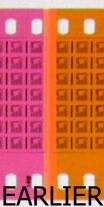Tinting and toning samples
The set of samples, displayed at the picture, was created using strips of classic black/white film, whose pictures are formed by metallic silver. The silver is still present there, either as black and white image (tinting), or in chemically modified form (toning).
.jpg)
Detailed information about displayed samples:
There are together 5 strips of film samples with different coloration - toning, tinting, or both toning+tinting. The first (upper) sample - there is one single frame of film without coloring (no toning, no tinting) for comparison. Followed by three frames only tinting - no toning, tinted to yellow-orange. The next three frames contain no tinting, brown toning. The second strip (as original used bw image with a line test, the highest resolution 160 lines/mm) - there is present only tinting, two colors: magenta (3 frames) and orange (4 frames). No toning there. The strip no. 3 is a test picture again, this one used for testing telecine equipments. Two frames colored yellow, next five green. Again, no toning there. Next two strips in this one package contain complete toning - blue, with or without tinting. The strip no. 4 contains two frames with azure tinting, what means that there are two frames with combination blue toning - azure tinting. Next three frames contain the combination of blue toning - magenta tinting. The last two frames contain only blue toning, no tinting. The last strip, no. 5, contains two film frames with only blue toning, followed by five frames with combination of blue toning - yellow tinting.

 At described samples also possible to observe, that used method enables to
move the exact position of color change, where requested. Sooner, say, between 1990 and 2008, used method was not so exact, and the color change was not so sharp. Occupied a place in the approximate range of the distance between two perforation holes, and the change was gradual, not as sharp as possible observe on the described set of samples.
At described samples also possible to observe, that used method enables to
move the exact position of color change, where requested. Sooner, say, between 1990 and 2008, used method was not so exact, and the color change was not so sharp. Occupied a place in the approximate range of the distance between two perforation holes, and the change was gradual, not as sharp as possible observe on the described set of samples.
At the samples 2 and 3, using bw test films (with standard, normalised frame positon exactly in the middle between perforation), is the color change position located also exactly in the middle between frames/perforation. At the sample one it is a little shifted, where needed (due to inaccuracy of the nitrate original), and at the samples 4 and 5 is the position shift (originated for the same reason) much better visible.
.jpg)